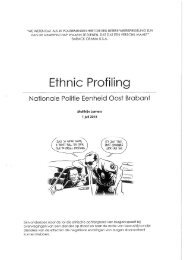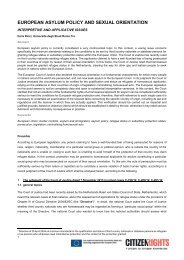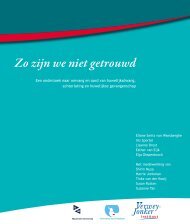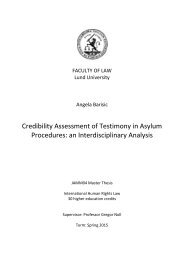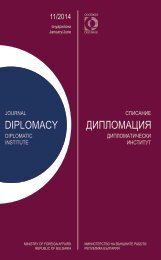AEMI
AEMI-2016-web
AEMI-2016-web
Create successful ePaper yourself
Turn your PDF publications into a flip-book with our unique Google optimized e-Paper software.
NONJA PETERS<br />
and myrrh trees were seen as a source of wealth<br />
by its rulers. The demands for scents and incense<br />
by the empires of antiquity, such as Egypt, Rome<br />
and Babylon, made Arabia one of the oldest trade<br />
centres of the world.<br />
8 The Persian Royal Road ran from Susa, in north<br />
Persia (modern day Iran) to the Mediterranean Sea<br />
in Asia Minor (modern day Turkey) and featured<br />
postal stations along the route with fresh horses<br />
for envoys to quickly deliver messages throughout<br />
the empire. The Persians maintained the Royal<br />
Road carefully and, in time, expanded it through<br />
smaller side roads. These paths eventually crossed<br />
down into the Indian sub-continent, across Mesopotamia,<br />
and over into Egypt; The Incense trade<br />
route or the Incense Road of Antiquity (see also<br />
the spice trade) comprised a network of major<br />
ancient land and sea trading routes linking the<br />
Mediterranean world with Eastern and Southern<br />
sources of incense, spices and other luxury goods,<br />
stretching from Mediterranean ports across the<br />
Levant and Egypt through Northeastern Africa<br />
and Arabia to India and beyond. The incense land<br />
trade from South Arabia to the Mediterranean<br />
flourished between roughly the 7th century BCE<br />
to the 2nd century CE. The Incense Route served<br />
as a channel for trading of goods such as Arabian<br />
frankincense and myrrh; Indian spices, precious<br />
stones, pearls, ebony, silk and fine textiles;[2] and<br />
the Horn of African rare woods, feathers, animal<br />
skins and gold.<br />
9 Abbreviated as CE, is an alternative naming of the<br />
calendar era, Anno Domini.<br />
10 http://www.nhcgroup.com/spice-history/<br />
11 http://www.ancient.eu/Silk_Road/<br />
12 Sogdiana, at different times, included territories<br />
around Samarkand, Bukhara, Khujand, Panjikent<br />
and Shahrisabz in modern Tajikistan and Uzbekistan.<br />
Peoples of the ancient civilization of an Iranian<br />
peoples.<br />
13 Trade on the Silk Road was a significant factor<br />
in the development of the civilizations of China,<br />
the Indian subcontinent, Persia, Europe and Arabia.<br />
It opened long-distance, political and economic<br />
interactions between the civilizations.[5]<br />
Though silk was certainly the major trade item<br />
from China, many other goods were traded, and<br />
various technologies, religions and philosophies,<br />
as well as the bubonic plague (the “Black Death”),<br />
also traveled along the Silk Routes. In addition to<br />
economic trade, the Silk Road served as ways of<br />
carrying out cultural trade between the networking<br />
civilizations.<br />
14 Edward Gibbon in The History of the Decline and<br />
Fall of the Roman Empire. During the Reformation<br />
and Counter-Reformation of the 16th century,<br />
129<br />
historians saw the Crusades through the prism of<br />
their own religious beliefs. Protestants saw them<br />
as a manifestation of the evils of the Papacy, while<br />
Catholics viewed the movement as a force for good.<br />
During the Enlightenment, historians tended to<br />
view both the Crusades and the entire Middle<br />
Ages as the efforts of barbarian cultures driven by<br />
fanaticism. By the 19th century, with the dawning<br />
of Romanticism, this harsh view of the crusades<br />
and its time period was mitigated somewhat, with<br />
later 19th-century crusade scholarship focusing<br />
on increasing specialization of study and more detailed<br />
works on subjects. Enlightenment scholars<br />
in the 18th century and modern historians in the<br />
West have expressed moral outrage at the conduct<br />
of the crusaders. In the 1950s, Sir Steven Runciman<br />
wrote that “High ideals were besmirched by<br />
cruelty and greed ... the Holy War was nothing<br />
more than a long act of intolerance in the name<br />
of God”. In the 20th century, three important<br />
works covering the entire history of the crusades<br />
have been published, those of Rene Grousset, Steven<br />
Runciman, and the multi-author work edited<br />
by K. M. Stetton. A pluralist view of the crusades<br />
has developed in the 20th century inclusive of all<br />
papal-led efforts, whether in the Middle East or in<br />
Europe. Historian Thomas Madden has made the<br />
contrary argument that “[t]he crusade, first and<br />
foremost, was a war against Muslims for the defense<br />
of the Christian faith.... They began as a result<br />
of a Muslim conquest of Christian territories.”<br />
Madden says the goal of Pope Urban was that “[t]<br />
he Christians of the East must be free from the<br />
brutal and humiliating conditions of Muslim<br />
rule.”<br />
15 http://www.britannica.com/EBchecked/<br />
topic/144695/Crusades<br />
16 Riley-Smith, J., The Crusades, Christianity,<br />
and Islam (Bampton Lectures in America),<br />
Columbia University Press, 2008. http://cup.<br />
columbia.edu/book/the-crusades-christianity-and-islam/9780231146241<br />
17 Equivalent in fact to putting a man on the moon.<br />
18 https://books.google.com.au/books?id=4DU-<br />
UrDAiqcIC&pg=PA14&lpg=PA14&dq=Colonial+powers+in+the+Indian+Ocean&source=bl&ots=e0G0lMa9g&sig=eEQQ7OEdg-<br />
3MIbbGLiniJQrOFcgI&hl=en&sa=X&ei=qx-<br />
EwVartF4W7mAXqyIHoAw&ved=0CDAQ6A-<br />
EwAw#v=onepage&q=Colonial%20powers%20<br />
in%20the%20Indian%20Ocean&f=false<br />
19 Religions – The rise of capitalism in the East – pre<br />
Max Weber<br />
20 h ttp://www.encyclopedia.com/<br />
doc/1G2-2830906009.html<br />
21 It included a struggle about ownership of the




